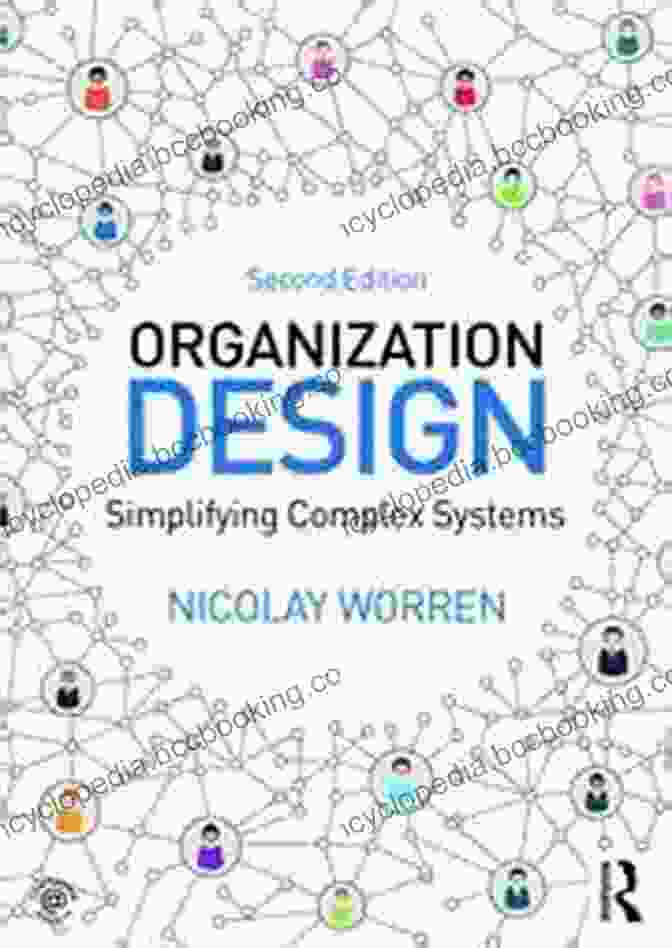Organization Design: Simplifying Complex Systems for Optimal Performance

In today's rapidly evolving business environment, organizations face unprecedented complexities. From managing distributed teams and ever-shifting market dynamics to leveraging technology and navigating regulatory landscapes, the challenges are immense. To thrive and stay competitive, organizations must embrace innovative approaches to organization design that simplify these complexities and empower them to achieve their strategic goals.
4.2 out of 5
| Language | : | English |
| File size | : | 5692 KB |
| Text-to-Speech | : | Enabled |
| Screen Reader | : | Supported |
| Enhanced typesetting | : | Enabled |
| Word Wise | : | Enabled |
| Print length | : | 328 pages |
Unveiling the Principles of Organization Design
Organization design is the art of aligning an organization's structure, processes, and people with its strategic objectives. It involves understanding the organization's mission, vision, and values, and creating a framework that enables effective coordination, collaboration, and decision-making. Effective organization design focuses on:
- Clear Definition of Roles and Responsibilities: Assigning specific tasks and accountabilities to individuals and teams ensures clarity and avoids overlap or confusion.
- Efficient Communication Channels: Establishing transparent and accessible communication pathways facilitates information sharing, collaboration, and quick decision-making.
- Empowered Decision-Making: Decentralizing decision-making authority to lower levels empowers teams, increases agility, and speeds up execution.
- Adaptability and Flexibility: Designing organizations to be responsive to changing market conditions and technological advancements ensures resilience and long-term success.
- Alignment with Organizational Culture: Integrating organizational design with the company's culture ensures values and behaviors align with strategic goals and day-to-day operations.
Navigating Organizational Complexity
Organizations can leverage various strategies to navigate complexity and optimize their design. These include:
- Matrix Structures: Combining functional and project-based teams to foster flexibility and cross-functional collaboration.
- Flatter Hierarchies: Reducing layers of management and empowering lower-level employees to promote agility and innovation.
- Process Optimization: Streamlining workflows, eliminating bottlenecks, and automating tasks to improve efficiency and reduce complexity.
- Knowledge Management: Creating systems to capture, share, and leverage organizational knowledge to inform decision-making and enhance collaboration.
- Technology Integration: Utilizing technology to automate tasks, facilitate communication, and enable data-driven decision-making to reduce manual complexity and increase productivity.
Empowering Teams for Enhanced Performance
Effective organization design empowers teams to perform at their best. By fostering collaboration, encouraging innovation, and providing resources, organizations can create environments where teams can thrive. Key considerations include:
- Diversity and Inclusiveness: Building teams with diverse perspectives, skills, and experiences enhances creativity and problem-solving capabilities.
- Role Clarity and Shared Goals: Defining clear roles, responsibilities, and aligning team members around shared objectives ensures focused efforts and accountability.
- Open Communication: Establishing an environment where team members can freely share ideas, concerns, and feedback promotes trust and effective collaboration.
- Access to Resources: Providing teams with the necessary resources, such as training, tools, and mentorship, empowers them to achieve their goals and contribute to organizational success.
- Recognition and Rewards: Acknowledging and rewarding team accomplishments fosters motivation, teamwork, and continuous improvement.
Driving Organizational Effectiveness
Organization design plays a pivotal role in driving organizational effectiveness. By simplifying complexity and optimizing team performance, organizations can:
- Increased Agility: Responsive organization designs enable quick decision-making, adaptation to changing market conditions, and the pursuit of new opportunities.
- Enhanced Innovation: Empowering teams and fostering collaboration creates an environment that nurtures creativity, idea generation, and experimentation.
- Improved Employee Engagement: Clear roles, opportunities for growth, and a sense of purpose increase employee satisfaction, motivation, and productivity.
- Optimized Resource Allocation: Effective organization design ensures resources are allocated efficiently, minimizing waste and maximizing the impact of investments.
- Long-Term Success: Organizations that embrace innovative organization design principles are better positioned to navigate challenges, adapt to future trends, and achieve sustainable growth.
Organization design is an essential discipline for navigating the complexities of modern business environments. By embracing the principles outlined in this article, organizations can simplify these complexities, optimize team structures, and drive organizational effectiveness. Remember, the key to successful organization design lies in tailoring it to the unique needs, culture, and strategic goals of your organization. With careful planning and implementation, you can transform your organization into a well-oiled machine that seamlessly adapts to change, fosters innovation, and achieves its full potential.
Call to Action
Embrace the power of organization design. Free Download your copy of "Organization Design: Simplifying Complex Systems" today and unlock the secrets to revolutionizing your organization's performance. This comprehensive guide will equip you with the knowledge, strategies, and tools to create an agile, innovative, and high-performing organization that thrives in the face of complexity.

4.2 out of 5
| Language | : | English |
| File size | : | 5692 KB |
| Text-to-Speech | : | Enabled |
| Screen Reader | : | Supported |
| Enhanced typesetting | : | Enabled |
| Word Wise | : | Enabled |
| Print length | : | 328 pages |
Do you want to contribute by writing guest posts on this blog?
Please contact us and send us a resume of previous articles that you have written.
 Book
Book Novel
Novel Page
Page Chapter
Chapter Text
Text Story
Story Genre
Genre Reader
Reader Library
Library Paperback
Paperback E-book
E-book Magazine
Magazine Newspaper
Newspaper Paragraph
Paragraph Sentence
Sentence Bookmark
Bookmark Shelf
Shelf Glossary
Glossary Bibliography
Bibliography Foreword
Foreword Preface
Preface Synopsis
Synopsis Annotation
Annotation Footnote
Footnote Manuscript
Manuscript Scroll
Scroll Codex
Codex Tome
Tome Bestseller
Bestseller Classics
Classics Library card
Library card Narrative
Narrative Biography
Biography Autobiography
Autobiography Memoir
Memoir Reference
Reference Encyclopedia
Encyclopedia Alan S Kaufman
Alan S Kaufman Al Owens
Al Owens Agnieszka Biskup
Agnieszka Biskup Adrienne Brodeur
Adrienne Brodeur Adam Vine
Adam Vine Aleksandar Nedeljkovic
Aleksandar Nedeljkovic Alana Mclaren
Alana Mclaren Alex Hibbert
Alex Hibbert 3rd Ed Edition Kindle Edition
3rd Ed Edition Kindle Edition Alan Deutschman
Alan Deutschman Acha Leke
Acha Leke Alex Morgan
Alex Morgan Abraham Lincoln
Abraham Lincoln Akihisa Ikeda
Akihisa Ikeda Adrian Mitchell
Adrian Mitchell Albus Mogs
Albus Mogs Adel Alsuhaimi
Adel Alsuhaimi Aaron Ehasz
Aaron Ehasz Adrienne Onofri
Adrienne Onofri Abby Whiteside
Abby Whiteside
Light bulbAdvertise smarter! Our strategic ad space ensures maximum exposure. Reserve your spot today!

 Aaron BrooksTradition, Community, and Red Power: A Comprehensive Guide to Native American...
Aaron BrooksTradition, Community, and Red Power: A Comprehensive Guide to Native American... Zadie SmithFollow ·17.6k
Zadie SmithFollow ·17.6k Stan WardFollow ·11.8k
Stan WardFollow ·11.8k Jean BlairFollow ·7.2k
Jean BlairFollow ·7.2k Chandler WardFollow ·11.3k
Chandler WardFollow ·11.3k Samuel Taylor ColeridgeFollow ·14.6k
Samuel Taylor ColeridgeFollow ·14.6k John GrishamFollow ·7.5k
John GrishamFollow ·7.5k Brody PowellFollow ·19.2k
Brody PowellFollow ·19.2k W.H. AudenFollow ·2.7k
W.H. AudenFollow ·2.7k

 Francis Turner
Francis TurnerArt and Politics in the Shadow of Music
Music has...

 Jaylen Mitchell
Jaylen MitchellHow Algorithms Are Rewriting The Rules Of Work
The workplace is...

 Chandler Ward
Chandler WardRio de Janeiro & Minas Gerais Footprint Handbooks:...
Embark on an extraordinary adventure through...

 David Mitchell
David MitchellThe Story of Depression: Understanding and Treating a...
Delving into the Shadows of...

 Al Foster
Al FosterStatistics Done Wrong: The Woefully Complete Guide
Tired of being...

 DeShawn Powell
DeShawn PowellJulia Child's Second Act: A Tale of Triumph,...
Julia Child is an...
4.2 out of 5
| Language | : | English |
| File size | : | 5692 KB |
| Text-to-Speech | : | Enabled |
| Screen Reader | : | Supported |
| Enhanced typesetting | : | Enabled |
| Word Wise | : | Enabled |
| Print length | : | 328 pages |









